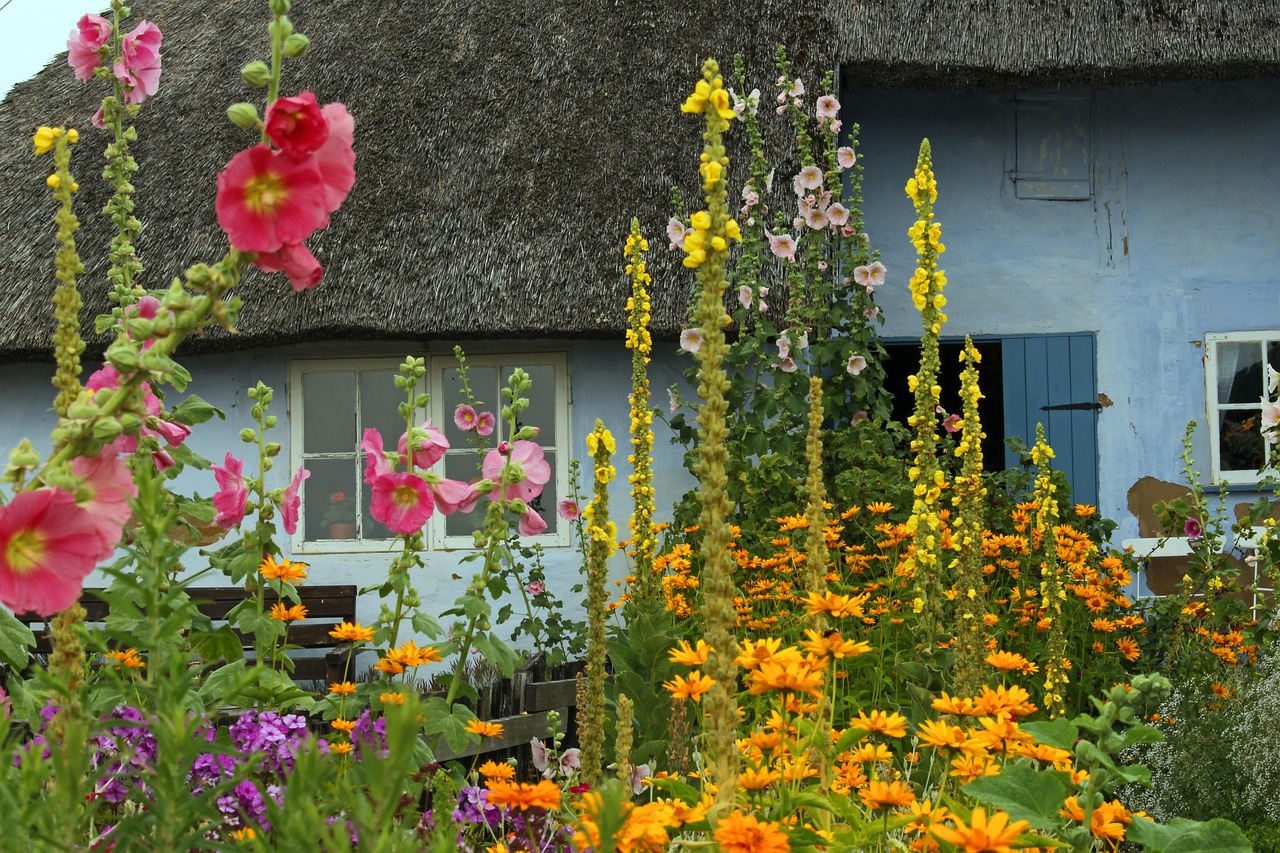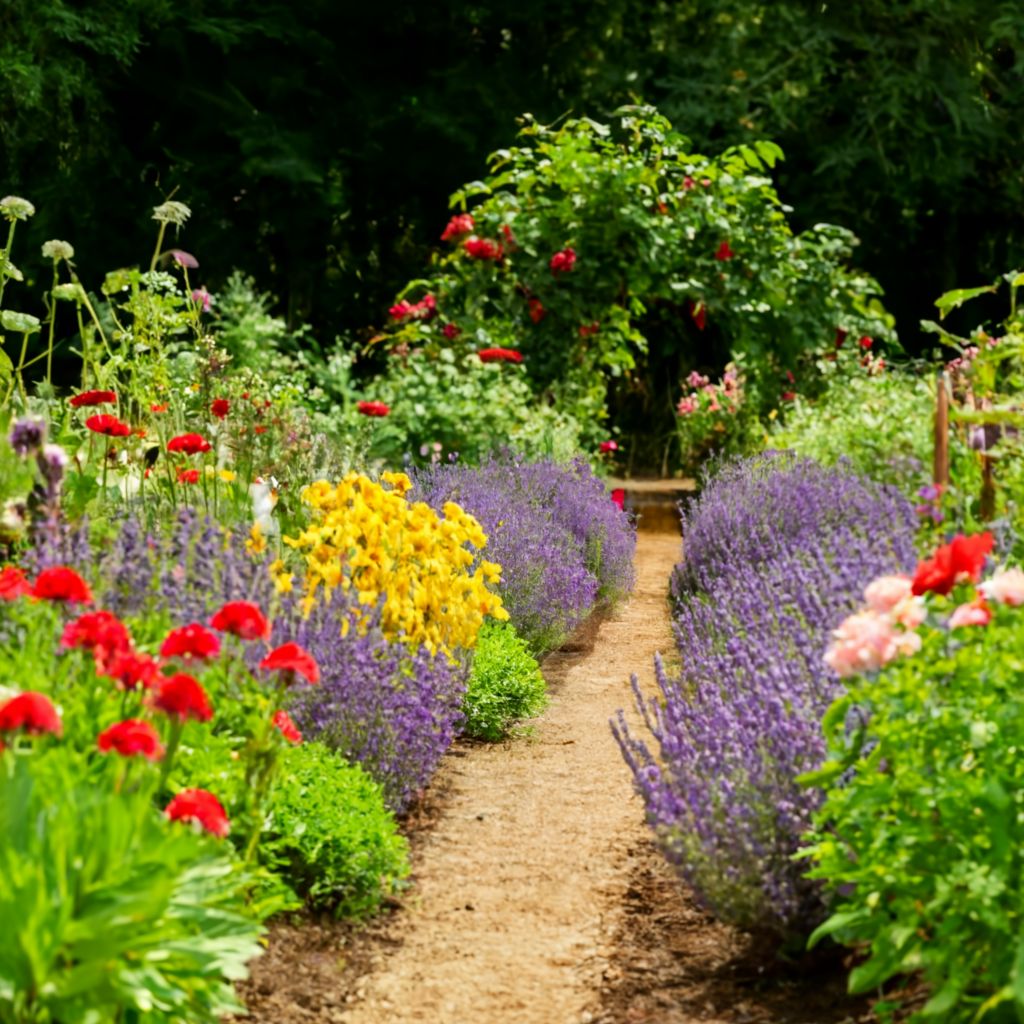
Ever dreamt of stepping into a scene straight out of a Jane Austen novel? Where roses sprawl over weathered brick walls, wildflowers dance in the breeze, and butterflies flit between vibrant blooms? Then an English cottage garden might be your horticultural haven. These gardens, overflowing with charm and a touch of wild abandon, are havens for nature lovers and a feast for the senses. But how do you capture that whimsical essence in your own backyard? Fear not, fellow gardener! Here are the secrets to weaving your own enchanting English cottage garden:
7 Secrets to Your Enchanting English Cottage Garden

1. Embrace Layers and Textures:
Unlike the manicured lawns of formal gardens, English cottage gardens revel in a delightful jumble. The key is creating layers of height and texture. Here’s where the magic begins:
- Building a Foundation with Shrubs and Climbers:
Start with a foundation of evergreen shrubs like holly or boxwood that provide year-round structure. Let climbing roses, clematis, or honeysuckle scale walls and fences, adding vertical interest and bursts of color. Imagine fragrant roses tumbling over a weathered stone archway, creating a picture-perfect entrance to your secret garden.
- The Mid-Ground Medley:
Fill the middle ground with a vibrant mix of perennials and flowering herbs. Foxgloves with their whimsical bell-shaped blooms, stately lavender with its heady fragrance, and fluffy phlox in a kaleidoscope of colors all contribute to the delightful chaos. Don’t be afraid to experiment with color combinations and plant heights for a dynamic display.
- A Carpet of Color with Groundcovers:
Complete the layered look with a carpet of colorful groundcovers. Creeping Jenny spills over stone pathways, while vibrant bluebells create a whimsical sea of color beneath towering trees. Think of groundcovers as the finishing touch, adding visual interest and preventing weeds from taking hold.
2. Let Nature Be Your Guide:
English cottage gardens are all about embracing a natural, slightly unkempt aesthetic. Here’s how to cultivate that effortless charm:
- Befriend Biodiversity:
Cottage gardens are a haven for pollinators! Opt for flowering plants rich in nectar and pollen, attracting bees, butterflies, and hummingbirds. This not only adds vibrancy to your garden but also supports a healthy ecosystem.
- Embrace the Unexpected:
Don’t be afraid to let your garden evolve organically. Allow self-seeding plants to surprise you with their unexpected beauty. A rogue poppy pushing through the lavender might just become your favorite focal point!
- Work with, Not Against, Nature:
Observe your garden’s natural light and moisture levels. Choose plants that thrive in these conditions to minimize maintenance and encourage a natural, balanced growth.
3. Paths with Purpose (and Charm):
Winding paths are a quintessential feature of English cottage gardens. They not only guide visitors on a delightful exploration but also add a touch of whimsy:
- Cobblestones or Stepping Stones:
Opt for charming pathways made of cobblestones, weathered flagstones, or stepping stones. These materials blend seamlessly with the natural aesthetic and provide a textural contrast to the surrounding greenery.
- Framed by Flowers:
Let your pathways become an extension of the garden itself. Plant low-growing flowers like creeping thyme or violas along the edges. This creates a sense of invitation and adds another layer of visual interest.
- Hidden Delights:
Tuck a charming bench or a birdbath along the path, creating inviting spots to rest and enjoy the sights and sounds of your blossoming haven.
4. Water Features for Whimsy:
The sound of trickling water adds a touch of serenity and magic to any garden. Consider these options to incorporate a water feature:
- A Cascading Fountain:
A small, cascading stone fountain tucked in a shady corner creates a peaceful retreat. The gentle sound of water adds a calming ambiance, perfect for quiet contemplation amidst the vibrant blooms.
- A Sunken Pond:
For a more ambitious project, consider a sunken pond. Plant water lilies and cattails around the edges, creating a natural habitat for frogs and dragonflies. This not only adds visual interest but also fosters a healthy ecosystem in your garden.
- The Music of Birdbaths:
Even a simple birdbath can make a big difference. Watching birds splash and preen adds a touch of life and movement to your garden, creating a delightful spectacle for you and your feathered friends.
5. Salvage and Upcycle for Vintage Charm:
English cottage gardens are a celebration of history and tradition. Here’s how to incorporate vintage elements:
- Reclaimed Treasures:
Give old furniture and tools a new lease on life. A weathered wheelbarrow overflowing with petunias becomes a charming focal point. An ornately carved wooden gate, salvaged from a flea market, adds a touch of grandeur to your garden entrance. Upcycling not only saves you money but also injects a unique personality into your space.
- Architectural Accents:
Dot your garden with architectural salvage finds. A collection of vintage clay pots overflowing with cascading greenery adds a touch of rustic charm. An antique birdbath, chipped and timeworn, becomes a conversation starter and a haven for thirsty birds.
- Let There Be Light:
String twinkling fairy lights through the branches of trees or drape them over pergolas. As dusk settles, these lights will create a magical, inviting atmosphere, perfect for evening strolls through your secret garden.
6. Embrace the Art of Scent:
Fragrance is a powerful tool that can transport you to another time and place. Here’s how to create a symphony of scents in your garden:
- Aromatic Herbs:
Plant fragrant herbs like lavender, rosemary, and chamomile throughout your garden. Not only will they add a touch of visual interest with their silvery foliage, but brushing past them will release a burst of delightful aroma.
- Old-Fashioned Roses:
Classic English roses with their heady fragrance are a must-have in any cottage garden. Choose varieties known for their strong scent, like David Austin roses, and plant them near pathways or seating areas to maximize their impact.
- Night-Blooming Beauties:
Don’t forget the magic of night-blooming flowers! Moonflowers unfurl their fragrant petals after dusk, filling the evening air with a sweet, intoxicating aroma. Imagine sitting on your porch swing, enveloped in the intoxicating scent of these nighttime beauties.
7. Invite Wildlife to Your Soiree:
English cottage gardens are a haven for all creatures, great and small. Here’s how to create a welcoming environment:
- A Haven for Pollinators:
Plant a variety of flowers with different bloom times to ensure a continuous food source for bees, butterflies, and hummingbirds. Include single-petaled flowers, as they are easier for pollinators to access the nectar within.
- Creature Comforts:
Provide nesting boxes for birds and create a small wildlife pond to attract frogs and dragonflies. A strategically placed pile of logs or brush can become a cozy haven for beneficial insects like ladybugs and lacewings, who will help control unwanted pests naturally.
- Dining Al Fresco:
Set up a charming bistro set or a hammock amidst the flowers. Imagine enjoying a cup of tea and a slice of homemade cake surrounded by the sights and sounds of your thriving ecosystem.
